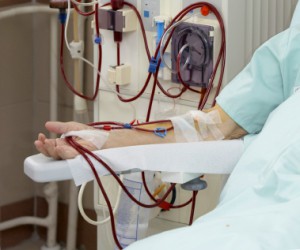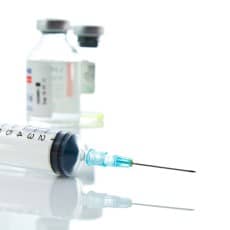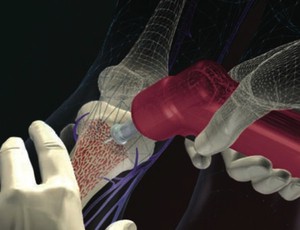Literature review of contrast media extravasation in CT and MRI

There are no uniformly accepted radiological guidelines or recommendations regarding detection and treatment of extravasation events and immanent complications in a timely manner” Mandlik et al (2018). Abstract: BACKGROUND: Contrast extravasation events in daily radiological routine may lead to serious complications, especially during CT examinations. The resulting symptoms may vary from local pain up to […]
Large-volume iodinated contrast medium extravasation

Our aim was to retrospectively investigate the frequency and outcome of large-volume iodinated contrast medium (CM) extravasation in our institution and to compare our management protocol to current practice” Ko et al (2018). Abstract: OBJECTIVES: Our aim was to retrospectively investigate the frequency and outcome of large-volume iodinated contrast medium (CM) extravasation in our institution […]
Choice of a second vascular access in hemodialysis patients whose initial arteriovenous fistula failed

There was no significant difference in the total cost of access care for hemodialysis patients receiving a secondary AVF vs AVG” Al-Balas et al (2018). Abstract: OBJECTIVE: We have previously shown that arteriovenous fistulas (AVFs) are more expensive to create and to maintain than arteriovenous grafts (AVGs) in patients undergoing their first access. Because those […]
Maintenance of the central venous catheters in children on long-term parenteral nutrition

CVC insertion and maintenance in children on home PN varies largely amongst centres in Europe. These differences could be at least partially explained by the lack of up-dated guidelines and limited evidence” Hojsak et al (2018). Abstract: BACKGROUND AND AIMS: The guidelines for the insertion and maintenance of the central venous catheter (CVC) in children […]
Impact of Centers for Medicare and Medicaid Services rules on withholding reimbursement

In 2008, the Centers for Medicare and Medicaid Services (CMS) stopped reimbursing for hospital-acquired conditions (HACs) not present on admission (POA). We sought to understand why this policy did not impact central line-associated bloodstream infection (CLABSI) and catheter-associated urinary tract infection (CAUTI) trends” Calderwood et al (2018). Abstract: OBJECTIVE: In 2008, the Centers for Medicare […]
Preserving skin integrity with chronic device use in diabetes

Skin integrity and diabetes device placement are ongoing concerns for people with diabetes who utilize continuous glucose monitors (CGMs) and continuous subcutaneous insulin infusion pumps” Messer et al (2018). Abstract: Skin integrity and diabetes device placement are ongoing concerns for people with diabetes who utilize continuous glucose monitors (CGMs) and continuous subcutaneous insulin infusion pumps. […]
Anemia and blood transfusion in elderly trauma patients

We hypothesized that elderly trauma patients would have lower admission hemoglobin (Hb) levels, higher transfusion rates, and worse outcomes than young trauma patients” Loftus et al (2018). Abstract: BACKGROUND: The natural history of postinjury among elderly trauma patients has not been well described. We hypothesized that elderly trauma patients would have lower admission hemoglobin (Hb) […]
Protocol examines types and frequency of infusion pump alarms

The objectives of this study protocol are to establish baseline data related to the types and frequency of infusion pump alarms from the B. Braun Outlook 400ES Safety Infusion System with the accompanying DoseTrac Infusion Management Software” Glover et al (2018). Abstract: BACKGROUND: The variety of alarms from all types of medical devices has increased […]
Prevalence of wireless smart-pump drug library update delays

Results of a study to estimate the prevalence and severity of delays in wireless updates of smart-pump drug libraries across a large group of U.S. hospitals are reported” DeLaurentis et al (2018). Abstract: PURPOSE: Results of a study to estimate the prevalence and severity of delays in wireless updates of smart-pump drug libraries across a […]
Assessment of safe injection practices in health facilities in Oman

We conducted a national cross-sectional survey in 2007 using the World Health Organization tool to evaluate injection safety practices. Using 2-stage cluster sampling, 80 government and 61 private health facilities were randomly selected and evaluated” Al Awaidy et al (2018). Abstract: BACKGROUND: Unsafe injection practices put patients and providers at risk of infectious and noninfectious […]
Will early availability of laboratory results increase same day ward discharge rates?

Early availability of blood results prior to ward rounds increased ward discharges but did not affect discharge time” Cornes et al (2018). Abstract: BACKGROUND: Delayed discharge reduces hospital efficiency and inconveniences patients. Most hospitals discharge in the afternoon, whereas the most common admission time is mid-morning. Consequently, new patients wait for the beds of patients […]
Staphylococcus aureus decolonization in patients on home parenteral nutrition

The CARRIER trial is designed to identify the most safe and effective long-term S. aureus carriage decolonization strategy in HPN patients” Gompelman et al (2018). Abstract: BACKGROUND: Patients with long-term intestinal failure are usually treated by means of home parenteral nutrition (HPN) where they administer their nutritional formulation intravenously via a central venous access device […]
Estimation of missed bloodstream infections without the third blood culture set

The aim of our study was to determine the proportion of BSIs that would be missed without the third BCS in a hospital where obtaining 3 BCSs is the standard of care” Blanco et al (2018). Abstract: OBJECTIVES: The question of whether to obtain 2 or 3 sets of blood cultures to assess the etiology […]
Wait time following a flush and minimum waste volume required to obtain an undiluted blood sample

“This study aimed to determine the appropriate wait time following a flush and the minimum waste volume required to obtain an undiluted blood sample when using the PIVO device and how that differed from current guidelines from SPC line draws” Adams et al (2018).
Electronic evidence-based medicine tool for vascular access planning

We have developed a tool, called AVATAR, aimed to make easier the implementation of a vascular access planning. It is a newly-designed tool, developed for the clinicians that must decide which type of venous access device is the ideal one in each single patient. It utilizes existing information that may not necessarily be only used […]
Nationwide use of disposable and non-disposable venepuncture tourniquets

The objective of this study was to investigate the nationwide use of disposable and non-disposable venepuncture tourniquets and the standardised procedures for cleaning the tourniquets” Petersen and Nybo (2018). Abstract: Tourniquets are widely used to make the vein more visible prior to blood collection. Venepuncture tourniquets are however a non-sterile and potentially reusable equipment. Several […]
Improving disaster preparedness of families with a parenteral nutrition-dependent child

The purpose of the study was to demonstrate that we could improve disaster preparedness of families with PN-dependent children utilizing individualized family education and distribution of personalized disaster survival toolkits” Toor et al (2018). Abstract: OBJECTIVES: Disruption in the care of special healthcare needs children may lead to life-threatening situations or preventable secondary conditions. California […]
Developing and testing the Difficult Intravenous Access (DIVA) tool

The DIVA tool gave novice nurses a reliable indication of the probable difficulty of an IV insertion and resulted in a change in the IV policy standard at the institution, which now limits the number of peripheral IV insertion attempts to two per nurse and four per patient, bringing current policy into alignment with the […]
Taurolidine versus saline locking in patients on home parenteral nutrition

In the new catheter group, taurolidine showed a clear decrease in CRBSI rate” Wouters et al (2018). Abstract: BACKGROUND: The catheter lock solutions 2% taurolidine and 0.9% saline are both used to prevent catheter-related bloodstream infections (CRBSIs) in home parenteral nutrition patients. AIMS: To compare the effectiveness and safety of taurolidine and saline. METHODS: This […]
Optimal vascular access strategies for patients receiving chemotherapy

Systemic chemotherapy can be administered either through a peripheral vein (IV), or centrally through peripherally inserted central catheter (PICC), totally implanted vascular access devices (PORTs) or tunnelled cuffed catheters. Despite the widespread use of systemic chemotherapy in patients with breast cancer, the optimal choice of vascular access is unknown” Robinson et al (2018). Abstract: IMPORTANCE: […]
PICC occlusion in the OPAT setting

In this retrospective study of 285 patients receiving outpatient parenteral antibiotic therapy (OPAT), duration of antibiotic, use of double-lumen catheters, and receipt of penicillin G and cloxacillin appeared to increase the risk of PICC occlusion” Lam et al (2018). Abstract: In this retrospective study of 285 patients receiving outpatient parenteral antibiotic therapy (OPAT), duration of […]
Clinical application of ECG-guided tip positioning in PICC placement
The objective of the study was to perform the control study between the electrocardiogram (ECG)-guided tip positioning and traditional radiological confirmation method in peripherally inserted central catheters (PICC) placement; the accuracy and applicability of ECG-guided tip positioning were investigated” Li et al (2018). Abstract: OBJECTIVE: The objective of the study was to perform the control […]
The daily management of PICC in critically ill cancer patients

We aimed to investigate the status of knowledge, attitude, and practice (KAP) toward the daily management of PICCs in critically ill cancer patients discharged from intensive care units” Chen metal (2018). Abstract: BACKGROUND: Peripherally inserted central catheters (PICCs) are widely used in critically ill cancer patients. We aimed to investigate the status of knowledge, attitude, […]
Programmatic change leads to enhanced resource utilization and efficiency in port placement

Central venous port (CVP) placement is performed by a variety of surgeons in different subspecialties, and our previous work suggests that individual surgeons-regardless of training-are the strongest predictor of outcomes. We sought to prospectively evaluate a programmatic shift toward a resource-conscious, patient-focused algorithm for this common and simple surgical procedure” Venkatesan et al (2018). Abstract: […]
Intraosseous access and intravenous access during cardiopulmonary resuscitation in adults

Our results indicated that the arrival times of a drug at the right and left ventricles are significantly lower with HIO than with BIV in an adult cardiac arrest model” Cho et al (2018). Abstract: AIM: The present study aimed to compare the ventricular enhancement time between humeral intraosseous access (HIO) and brachial intravenous access […]
Just-in-time training for intraosseous needle placement

We evaluated a JITT curriculum for the procedures of intraosseous (IO) needle placement and defibrillator use in a pediatric emergency department (ED) by comparing the trainees’ comfort level in performing those procedures independently (Kirkpatrick level 2a) and trainees’ knowledge of the procedures/equipment (Kirkpatrick level 2b) before and after the JITT” Itoh et al (2018). Abstract: […]
CLABSI risk factors associated with hemodialysis central venous catheters

To measure the incidence of infection in short-term central venous catheter for hemodialysis and to identify the associated risk factors” Schwanke et al (2018). Abstract: OBJECTIVE: To measure the incidence of infection in short-term central venous catheter for hemodialysis and to identify the associated risk factors. METHOD: Prospective cohort study conducted in a teaching hospital […]
Malposition risk factors during intracavitary electrocardiogram PICC tip placement

This study confirmed the feasibility of intracavitary electrocardiogram for peripherally inserted central catheter positioning and the limits of chest X-ray” Monard et al (2018). Abstract: OBJECTIVES: To confirm the feasibility of intracavitary electrocardiogram guidance to verify tip’s position during insertion of peripherally inserted central catheter and to identify clinical factors or intracavitary electrocardiogram patterns associated […]
Cost-effectiveness of antimicrobial lock solutions for the prevention of CLABSI

The aim of this study was to evaluate the cost-effectiveness of antimicrobial locks for the prevention of CLABSI” Pliakos et al (2018). Abstract: BACKGROUND: Antimicrobial lock solutions are a low-cost strategy that can reduce the incidence of Central Line-Associated Bloodstream Infections (CLABSI). The aim of this study was to evaluate the cost-effectiveness of antimicrobial locks […]
Hot compress with Chinese herbal salt packets reducing PICC complications

To explore the preventive effect of applying hot compress with Chinese herbal salt packets (CHSP) to puncture vessels under aseptic conditions during peripherally inserted central catheter (PICC) on postoperative phlebitis” Wu et al (2018). Abstract: OBJECTIVE: To explore the preventive effect of applying hot compress with Chinese herbal salt packets (CHSP) to puncture vessels under […]

